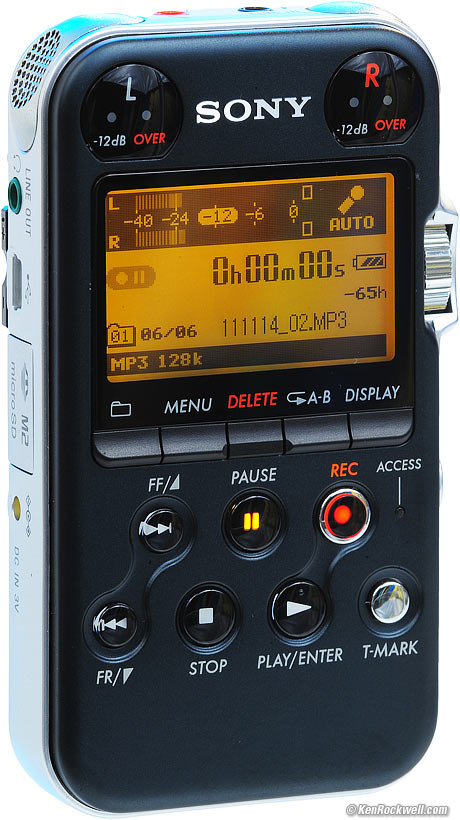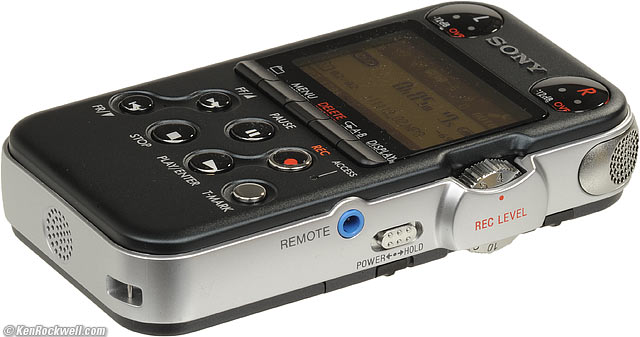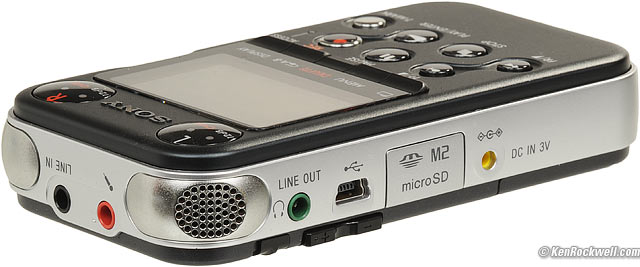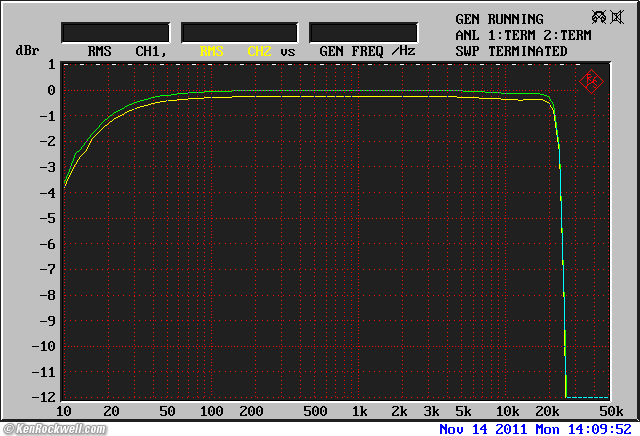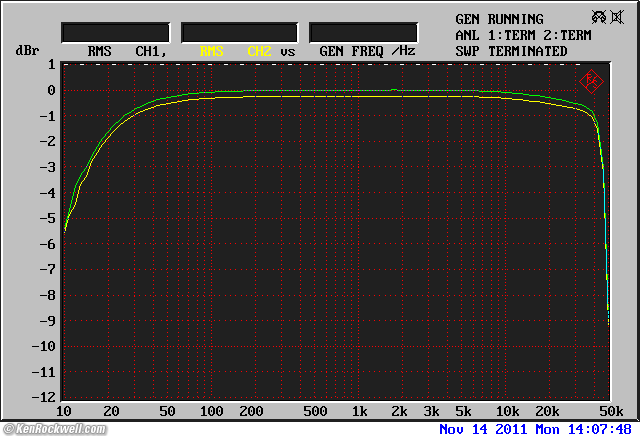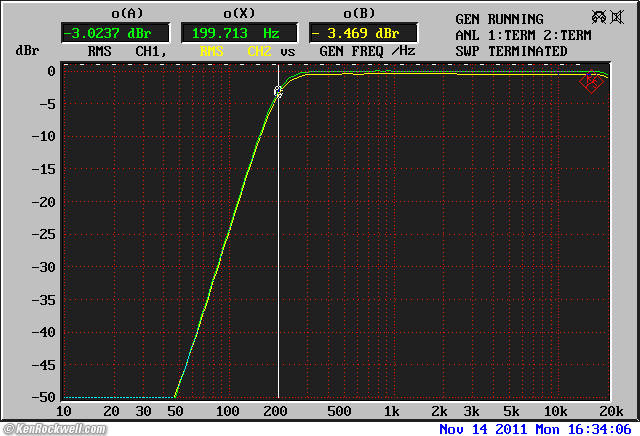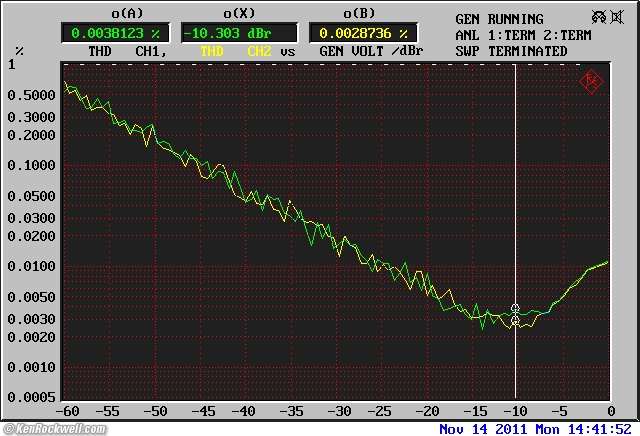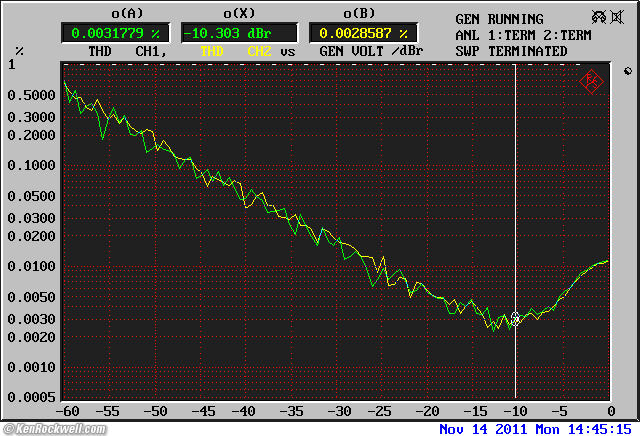Home Donate New Search Gallery Reviews How-To Books Links Workshops About Contact
Sony PCM-M10
Portable Digital Audio Recorder (2009-)
© 2011 KenRockwell.com. All rights reserved.
Intro Specs Performance Measurements Usage Recommendations More
Sony PCM-M10 (6.530 oz./185.15g with Ni-MH and 2GB card, about $230). larger. This free website's biggest source of support is when you use these links, especially this link directly to it at Adorama or directly to it at Amazon, when you get anything, regardless of the country in which you live. Thank you! Ken.
November 2011 All Reviews > Audio Reviews > Sony Reviews
Sample Recordings
Reading to the class from 2 meters: 6MB, 6-minutes at 128 kbps MP3 Stereo. (note: the hum and rumble are accurate renditions of the sounds in the room. There's a fish tank pump 4 meters away, and plenty of rustling and kids running around.)
Porsche Cayenne Turbo S idling at 3 meters: 324 kB, 30 seconds at 128 kbps MP3 Stereo. (note: noise is trees rustling in the breeze.)
Introduction top
Intro Specs Performance Measurements Usage Recommendations More
|
Adorama pays top dollar for your used gear. I use Adorama, Amazon, eBay, Ritz, B&H, Calumet, J&R and ScanCafe. I can't vouch for ads below.
|
The Sony PCM-M10 is a 96 kHz/24-bit portable digital recorder that runs on two AA cells, USB power or the included 3VDC AC adapter.
The pocketable Sony PCM-M10's technical performance and build quality are significantly better than the more expensive Zoom H4n and the dinky Tascam DR-08. Unlike anyone else making portable recorders today, Sony has been making $50,000 professional digital audio recorders since the 1970s, and this experience shows.
The PCM-M10 records as .WAV or as .MP3 files from its own stereo microphones, line or mic inputs. It has a rotary ganged stereo recording level control on the side. It plays many other kinds of files, including AAC and WMA.
This recorder works for for anything, especially audio for DSLR or other video. You put this recorder up at your subject and let it run, then use software like Plural Eyes to sync the audio to video later. You shoot from where you need to shoot, and the audio is recorded clear and up-close in either direct-to-MP3 or up to glorious 96kHz/24-bit digital stereo separately from your DSLR without any big mics on-camera, or even any wires.
It works great and is super-easy to figure out and immediately record broadcast-quality files. When the REC light is blinking, you're ready, and when REC is solid, you're rolling. Want to make a great downloadable file? Just set it to 128 kbps MP3, record, and upload. Done.
Rear, Sony PCM-M10. larger.
Features
Batteries and wired remote control included.
44.1, 48 and 96 kHz (ksps, kilo-samples per second) recording at 16- or 24-bits as WAV files.
22.05 kHz (ksps) recording at 16-bit WAV.
MP3 44.1 kHz (ksps) recording at 64kbps (kilo-bits per second), 128kbps or 320bps.
Also plays other MP3 at 32-320 kbps, WMA at 32-192 kbps, AAC-LC (m4a) at 16-320 kbps.
Separate 3.5mm stereo Mic and LINE inputs, Mic power if needed.
Light-up PAUSE, PLAY and REC buttons (cancelable).
Track marking.
4GB hard-wired internal memory, and a MicroSD/M2 card slot.
Unlimited Eternal recording by letting the internal memory cover you during card swaps.
Counter displays Hours, Minutes, Seconds.
Auto and manual record level control.
Selectable limiter.
Selectable 200 Hz, 24dB/octave low-cut filter.
Level meters can be set to read while playing back.
Built-in 16mm speaker on bottom.
¼"-20 tripod socket.
Output can drive speakers directly, but only at low levels.
Playback tempo (speed) variable from 25% to 200% without pitch change. 5% intervals for slower and 10% intervals for faster.
Variable pitch playback, sharp or flat 6 semitones.
Playback bass boost.
Also works as a USB card reader, and the built-in 4GB of memory also can be seen on your computer via USB. It's easy to copy music files into the PCM-M10 to use it as a music player.
Missing
I never could figure out how to get the Margin (maximum held level) display to hold the maximum for the length of a selection.
No time-code.
No digital audio inputs or outputs other than as files.
Doesn't appear to work as a USB DAC or USB ADC.
Right, Sony PCM-M10. larger.
Left, Sony PCM-M10. larger.
Included
Box, Sony PCM-M10. larger.
PCM-M10 recorder.
Wired remote control.
Two Sony AA Alkaline cells.
AC Adapter.
USB cable.
Hand strap.
(Wind screen only with PCM-M10P version)
CD-ROM with Sound Forge Studio LE software and PDF of the users manual.
Genuine printed copy of the users manual.
Rated Specifications top
Intro Specs Performance Measurements Usage Recommendations More
See also the Sony PCM-M10 users manual.
Inputs
Mics
Two built-in cardioid mics.
58mm spacing (33% of the 170mm spacing of the human ears).
123 dB SPL maximum.
-33.0 dB output at 1 Pa (94 dB SPL) at 1 kHz.
17.0 dB SPL (A) self-noise level, which is pretty darn good!
20 - 20,000 Hz.
Sony PCM-M10 Microphone Specifications.
3.5mm Sockets (2)
Stereo mic input (powered): 22k Ω or 3.9 k Ω depending on where you read it, 0.9 mV minimum, 2.5 mV rated.
Stereo LINE input: 22 kΩ, 500 mV minimum, 2 V rated.
Frequency Response
20-40,000 Hz +0 -2 dB, @ 96 ksps.
20-22,000 Hz +0 -2 dB, @ 48 ksps.
20-20,000 Hz +0 -2 dB, @ 44.1 ksps.
20-10,000 Hz +0 -3.5 dB @ 22.05 ksps.
50-15,000 Hz +0 -3 dB @ 320 kbps MP3.
50-15,000 Hz +0 -3 dB @ 128 kbps MP3.
50-13,000 Hz +0 -3 dB @ 64 kbps MP3.
Signal-to-Noise Ratio
87 dB, A-weighted, at 24 bits LPCM, LINE in to LINE out.
THD
0.03% at 1 kHz, 22 kHz bandwidth.
Storage
4 GB internal.
microSD/microSDHC cards or Memory Stick Micro (M2).
64 MB ~ 16 GB.
Outputs
One 3.5mm socket for either headphones or for LINE output (selectable in menus).
Headphones: 16 Ω load, 20 mW per channel.
LINE out: 22k Ω load, 1 VRMS rated output.
mini-B USB connector.
16mm speaker.
Power
Rated 270 mW power consumption.
Two AA cells, Alkaline or Ni-MH (select in menu for best battery gauge performance).
Rated about 24 hours of use.
USB power.
Optional 3VDC AC adapter.
Size
21.8 x 62 × 114 millimeters HWD.
0.86 x 2.44 × 4.49 inches HWD.
Weight
6.530 oz./185.15g with Ni-MH and 2GB card, measured.
6.6 oz. (187g), with two AA alkaline, rated.
Environmental
+5º ~ 35ºC operating.
+60ºC maximum storage.
Quality
Made in China.
Optional
Stereo headphones MDR-7502, MDR-7509HD, MDR-EX300SL, MDR-EX500SL, MDR-V300
Electret condenser microphone ECM-MS957
Audio connecting cable RK-G129
Rechargeable battery NH-AA-B2K
Battery charger BCG-34HS2K
Carrying case speaker CKS-M10
Wind screen AD-PCM2
Tripod VCT-PCM1
Performance top
Intro Specs Performance Measurements Usage Recommendations More
Sound quality depends far more on your ability as a recording engineer than on this recorder. Placement is everything. Recording engineers spend careers learning better and better ways to place microphones.
That said, this recorder is quite transparent; it works very well: it's clean, noise-free and wideband. It's technical performance is far better than the cheap Tascam DR-08 and also much better than the bigger and more expensive Zoom H4n.
Bloodline is important. Sony invented the portable digital audio recorder in 1981 (the Sony PCM-F1), and knows what they are doing. These 30 years of experience are in this little recorder, something no one else in this field has.
Sound
The mics and complete recorder sound quite nice. I can't hear anything missing or colored. The true (spaced-mic) stereo is much more spacious than the one-dimensional X-Y only sound of the Zoom H4n, and the PCM-M10 doesn't suffer from the slight upper midrange boost of the H4n.
Listen to these sample recordings:
Reading to the class from 2 meters: 6MB, 6-minutes at 128 kbps MP3 Stereo, AUTO level control.
Porsche Cayenne Turbo S idling at 3 meters: 324 kB, 30 seconds at 128 kbps MP3 Stereo, manual level control.
In AUTO level control, the levels don't get as loud as with the Tascam DR-08 in its AUTO level control.
Much better than the Tascam DR-08, in AUTO level control, I can't get the PCM-M10 to distort if I yell into it.
Ergonomics
Sony PCM-M10. larger.
The PCM-M10 is easy to use. It only takes a moment to set it up for your first recording, after which, you're set. I found no need for the Sony PCM-M10 users manual.
It takes only a few seconds to turn on, never 30 seconds like the Zoom H4n.
The PLAY, PAUSE and REC buttons are lit from behind. A menu option lets you turn these off.
The little -12dB and OVER LEDs are a great idea, except that they are too dim to see except at night.
For dates, the year 2011 shows only as "11y"
This little recorder feels much nicer nice all around than expected; it's a much higher quality product in every way than the more expensive Zoom H4n.
When recording, an annoyance is that the peak level "Margin" display keeps resetting, instead of holding at the maximum for each take.
There is no confidence head; you don't really know that your file will play back until you're done.
There are no power-on or power-off thumps.
Mechanics
It's nicer than I expected. The face feels like metal, and the rear battery door is hinged so it doesn't fall off. The bottom has nice rubber feet so it sits nicely on glass tables.
Data
When plugged into a computer, it pops right up as a drive labeled "PCMRECORDER." Easy!
Files are labeled as YYMMDD_##.MP3.
## resets each day to 01.
Playback
The output levels are only 1.5 dB more than an iPod touch, so whatever you get out of an iPod is what you'll get out of the PCM-M10's headphone jack.
This means its more than enough for use with the Ultrasone Edition 8, but not quite what you'd want for use with a 600 Ω Beyer DT880. The DT880s sound great with the PCM-M10, just that they may not go as loud as you prefer at full gain.
When playing AAC files copied from iTunes, it reads the titles and artists.
Measurements top
Intro Specs Performance Measurements Usage Recommendations More
The Sony PCM-M10 measures much, much better than the Zoom H4n or Tascam DR-08. Sony has been making professional $50,000 audio recorders since the 1970s and has learned a trick or two. Sony also makes its own audio chips, so its supremacy here was expected. This little recorder performs as it should, even though a 1990s DAT recorder is still better, while the Zoom H4n and Tascam DR-08 look pretty bad in the lab.
All measurements here are as powered by two Sanyo AA Eneloop. The advantage of this is complete isolation as compared to using USB or an AC adapter.
I used a $50,000 Rohde & Schwarz UPL laboratory audio analyzer to perform these measurements.
Input Levels
OVER lights a little before 0 dBFS.
Line Input
Gain set to |
RMS Input for 0 dBFS |
Relative Attenuation |
10 |
496 mV |
0.00 dB |
9 |
503 mV |
-0.12 dB |
8 |
540 mV |
-0.85 dB |
7 |
646 mV |
-2.2 dB |
6 |
885 mV |
-5.0 dB |
5 |
1.31 V |
-8.1 dB |
4 |
2.03 V |
-12.7 dB |
3 |
4.50 V |
-19.2 dB |
2 |
10.0 V |
-27 dB |
1 |
>10 V |
-34 dB |
0 |
> 10V |
-73 dB |
Mic Inputs
Gain set to |
RMS Input for 0 dBFS |
Relative Attenuation |
10 |
9.6 mV |
0.00 dB |
9 |
9.9 mV |
-0.13 dB |
8 |
16 mV |
-2.2dB |
7 |
18.5 mV |
-5.5 dB |
6 |
27 mV |
-11.1 dB |
5 |
50 mV |
-15.2 dB |
4 |
93 mV |
-20.7dB |
3 |
204 mV |
-27.8 dB |
2 |
489 mV |
-36.8 dB |
1 |
980 mV* |
-42 dB |
0 |
- |
-82 dB |
* Mic preamp clips at 980 mV, at gain = 1 = 0 dBFS.
Oddly, the relative attenuation of what sounds like a traditional stereo pot varies with the selected input.
As a traditional stereo pot, channel tracking will vary (balance will vary with level).
Input Level Control Channel Tracking (LINE Input)
Sony PCM-M10 Record level control channel imbalance (R versus L). (R&S UPL.)
This shows us that the balance shifts a tiny amount to the left at lower level settings, nothing over which to lose sleep. By using a real potentiometer instead of digital control we get real-time infinitely precise level control instead of fixed steps controlled by buttons.
Output Levels
set to Headphones (default):
Output Load Impedance |
MOL at 0.1% THD at 1 kHz |
200kΩ |
1.30V |
600 Ω |
1.25 V (2.6 mW) |
300 Ω |
1.25 V (5 mW) |
B&W 705 Loudspeaker, 8 Ω |
0.65 V (53mW) |
At 0 dBFS, playback level starts to clip at level 29 and level 30, making level 28 the maximum to use without distortion.
If the menu is used to set the output to LINE instead of Headphone, all it really does is fix the gain.
Set to Line Out:
Output Load Impedance |
MOL at 0.1% THD at 1 kHz |
200kΩ |
1.00V |
600 Ω |
1.00 V |
300 Ω |
1.00 V |
Playback Level Control Channel Tracking
The output level control is a 31-step digital attenuator which tracks very well as expected:
Sony PCM-M10 playback level control channel tracking. (R&S UPL.)
Output Source Impedance
Set to line or headphones, the analog output source impedance measures 0.72 Ω (720 milliohms) at 1 kHz.
Frequency Response
44.1 kHz/16-bit WAV:
Sony PCM-M10 Frequency Response, Line input 44.1 kHz/16-bit. (R&S UPL.)
48 kHz/16-bit WAV:
Sony PCM-M10 Frequency Response, Line input 48 kHz/16-bit. (R&S UPL.)
96 kHz/16-bit WAV:
Sony PCM-M10 Frequency Response, Line input 96 kHz/16-bit. (R&S UPL.)
As expected, the high frequency extension varies with sample rate.
Low-Cut Filter
The low-cut filter is extreme, 24 dB/octave at 200 Hz! It will remove all low frequencies, not just rumble and the proximity effect.
Sony PCM-M10 Low-Frequency Filter Response, Line inputs. (R&S UPL.)
Distortion
The Sony PCM-M10 has significantly less distortion than the Zoom H4n or the Tascam DR-08. This Sony measures as it should, while the technical performance of those other recorders are embarrassing.
THD versus level, line in to headphones out
Sony PCM-M10 THD versus level, 44.1 kHz/16-bit. (R&S UPL.)
Sony PCM-M10 THD versus level, 96 kHz/24-bit. (roll mouse-over to compare to 44.1/16.)
These were measured with 2V RMS LINE input, gain just below 4, output at 30 (max), 1.2 V RMS at 0 dBFS. The input level was varied from 2 mV to 2 V RMS for this test.
Noise
Idle Output Noise
A-weighted with 200kΩ load while idle (neither playing nor recording):
Output Gain set to |
Idle Output Noise |
30 |
-110.0 dBV A |
20 |
-113.1 dBV A |
10 |
-113.1 dBV A |
0 |
-113.1 dBV A |
Fixed (line out) |
-113.1 dBV A |
Signal-to-Noise Ratios
Line Input
1 V at 1 kHz, input gain just above 6, output at maximum (1.2 VRMS), measured analog input to analog output:
89.0 dB (A-weighted) at 96/24 bits WAV.
89.0 dB (A-weighted) at 44.1/24 bits WAV.
91.6 dB (A-weighted) at 44.1/16 bits WAV.
89.0 dB (A-weighted) at MP3/128kbps.
91.6 dB down from 1 V is 26.3 µV (-91.6 dBV) EIN (equivalent input noise).
MIC Input
50 mV at 1 kHz, input gain at 5, output level set to at 28 (1.2 VRMS), measured analog input to analog output:
89.6 dB (A-weighted) at 96/24 bits WAV.
89.5 dB (A-weighted) at 44.1/24 bits WAV.
89.2 dB (A-weighted) at 44.1/16 bits WAV.
89.2 dB (A-weighted) at MP3/128kbps.
89.2 dB down from 50 mV is 1.73 µV (-115 dBV) EIN (equivalent input noise).
Usage top
Intro Specs Performance Measurements Usage Recommendations More
See also the Sony PCM-M10 users manual.
The Sony PCM-M10 recorder works for for anything, especially for audio for DSLR or other video. You put this recorder up at your subject and let it run, then use software like Plural Eyes to sync the audio to video later. You shoot from where you need to shoot, while the audio is recorded clear and up-close in either direct-to-MP3 or up to glorious 96kHz/24-bit digital stereo, separately from your DSLR without any big mics on-camera, or even any wires.
You can't just plop it down and go. Recording engineering is an art: microphone placement is everything to recorded sound.
The Auto Level control works great for voice, interviews and presentations. I can't hear it pumping.
I'd use MP3/128k if you want to broadcast the files directly as-is on the internet. The MP3/64kbps setting is for voice note-taking, not for music. The 320kbps MP3 setting is for slightly cleaner MP3 files with double the file size of 128kbps.
If you're going to edit before distribution, I'd use the PCM settings. I'd use 16-bit instead of the 24-bit settings because the 24-bit settings offer no additional audible or measurable quality increase, but waste 50% more file space for bigger files with less recording time. In other words, recording at 24-bits just records 16 bits of audio with 8 extra bits of noise. 16-bits are more than enough to handle the analog circuits of this $300 recorder. To make full use of 24-bits requires much higher-end microphones, preamps and ADCs than in this recorder.
Choose 48 kHz (ksps) for video, TV and film, and 44.1 kHz (ksps) for CD release.
If you want to swap cards while recording, see "Cross-Memory Recording" on page 39 of the Sony PCM-M10 users manual.
The low-cut filter is severe. Avoid using it.
To connect to a computer, just plug it in. Even if the power is off, it will wake up and connect.
After disconnecting from USB, the power stays on, so remember to turn it off.
With a micro SD card, the card and the internal 4 GB memory come up as two drives on your computer.
If you want to see the level meters in playback, you may activate them in a menu.
The clock will need to be reset if the PCM-M10 goes for more than 3 minutes without batteries.
I prefer to set the LCD light to stay on longer than its default, an easy change in the menus.
Recommendations top
Intro Specs Performance Measurements Usage Recommendations More
The Sony PCM-M10 is my favorite portable stereo recorder. It offers excellent technical, sound, ergonomic and audio quality in a small, well-built and inexpensive package.
If you've found my research and laboratory time that I share here for free helpful, this free website's biggest source of support is when you use these links, especially this link directly to it at Adorama or directly to it at Amazon, when you get anything, regardless of the country in which you live. Thank you! Ken.
More Information top
Sony PCM-M10 Microphone Specifications.
Help me help you top
I support my growing family through this website, as crazy as it might seem.
The biggest help is when you use any of these links to Adorama, Amazon, eBay, Ritz, Calumet, J&R and ScanCafe when you get anything, regardless of the country in which you live. It costs you nothing, and is this site's, and thus my family's, biggest source of support. These places have the best prices and service, which is why I've used them since before this website existed. I recommend them all personally.
If you find this page as helpful as a book you might have had to buy or a workshop you may have had to take, feel free to help me continue helping everyone.
If you've gotten your gear through one of my links or helped otherwise, you're family. It's great people like you who allow me to keep adding to this site full-time. Thanks!
If you haven't helped yet, please do, and consider helping me with a gift of $5.00.
As this page is copyrighted and formally registered, it is unlawful to make copies, especially in the form of printouts for personal use. If you wish to make a printout for personal use, you are granted one-time permission only if you PayPal me $5.00 per printout or part thereof. Thank you!
Thanks for reading!
Mr. & Mrs. Ken Rockwell, Ryan and Katie.
Home Donate New Search Gallery Reviews How-To Books Links Workshops About Contact

